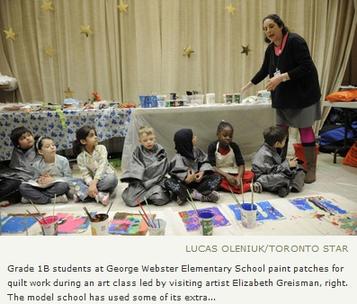Multi-Purpose Community Learning Spaces
In Chinese philosophy, the concept of yin yang is used to describe how seemingly contrary forces are interconnected and interdependent in the natural world, and how they give rise to each other in turn.
This concept can also be used to describe the future of the physical school building. While on one hand, ubiquitous learning calls for anytime anywhere learning, be it in the school, in the community or in the cyber world, the school itself needs to become a vital community hub, not just for 9-3 classes, but as a co-location for child care, senior centres, community recreation centres, libraries, internet access, social services, swimming pools, and other community associations/service clubs.
According to the Toronto District School Board’s (TDSB) report on Full Service Schools (2009) Using public school as hubs, community schools knit together inventive, enduring relationships among educators, families, volunteers and community partners…These partnerships are organized around two common goals…1) helping students learn and succeed and 2) strengthening families and communities. By sharing expertise and resources, schools and communities act in concert to transform traditional schools into permanent partnerships for excellence” (p.3)
The report goes on to describe how “Community schools recognize that students who are physically, socially, and emotionally competent tend to succeed academically. Autonomy, awareness of others, responsibility and rational optimism all inform academic achievement. In traditional schools, students who lack these essential non-academic skills are, for the most part, left to acquire them outside school. This is not the case in community schools, where students have abundant opportunities for learning and exploration in school, after school, and in the community…[therefore,] school hubs serve as a critical resource to meet the growing need for children to have safe and productive activities during the hours outside the school day.” (pp.3-4).
According to Ogilvie and Zimmerman (2010) in "Opening School Grounds to the Community After Hours" developed for the State of California, the authors maintain that “all communities – rich or poor, rural or urban – have to figure out ways for large public (and sometimes non-profit) agencies to work together as partners…communication and relationship-building [are] critical in getting partners engaged and ensuring that everyone honors and benefits from the agreement.” (p.21)
The authors go on to describe profiles of four different types of joint use:
1. Unlocking the Gates: Allowing public access to outdoor school facilities during non-school hours
2. Indoor and Outdoor Access: Allowing public access to indoor and outdoor school facilities during nonschool hours
3. Non-profit Partnerships: Allowing “third party organizations” (such as YMCAs or Boys & Girls Clubs) to use indoor and outdoor facilities after school hours to operate programs.
4. Reciprocal Access: Allowing schools and other public and/or non-profit organizations to have reciprocal access to each other’s facilities
Community and School Cooperation
According to the TDSB, the key to the success of multi-use community schools lies in the ability of governments, school boards and the community to work together to achieve
common goals and objectives such as:
1. Rationalization of scarce and expensive resources
2. Elimination of obsolete funding models
3. Integration of school and adult education
4. Realization of the school as a cultural and leisure-time facility for community groups as well as a learning venue
5. Availability of “school” resources (gymnasiums, classrooms, workshops, kitchens etc) to community groups
6. Creation of a sense of community and belonging
7. Establishment of a self-help hub for the community at large
8. Reduction of the feelings of alimentation some youth feel in the “school” building
Case Study: George Webster Elementary School
 In Million Bucks Makes School ‘Heart Of The Community Kristin Rushowy reports how George Webster Elementary School, an inner city school in Toronto, Ontario, Canada, was turned into a community hub with funding from the Model Schools for Inner Cities Initiative which provides one million dollars a year to schools in needy neighbourhoods.
In Million Bucks Makes School ‘Heart Of The Community Kristin Rushowy reports how George Webster Elementary School, an inner city school in Toronto, Ontario, Canada, was turned into a community hub with funding from the Model Schools for Inner Cities Initiative which provides one million dollars a year to schools in needy neighbourhoods.
Since the program has been implemented at George Webster, math, reading, and writing skills have all go from below grade level to over grade level. Funds also provide extra release time for teachers to develop curriculum with a strong emphasis on social justice relevant to students’ lives and supplementary programs such as visiting artists in the school. Parent’s are quoted as saying “This school is not just looking after academics, but also the well being of children and their families”, as well as “This school is more like a community centre.”
Toronto's Inner City Model Schools
Next up, see Anywhere-Anytime Learning
